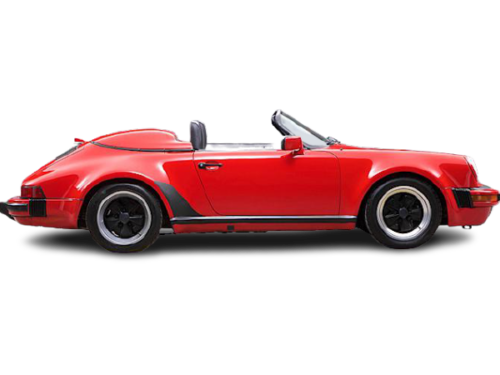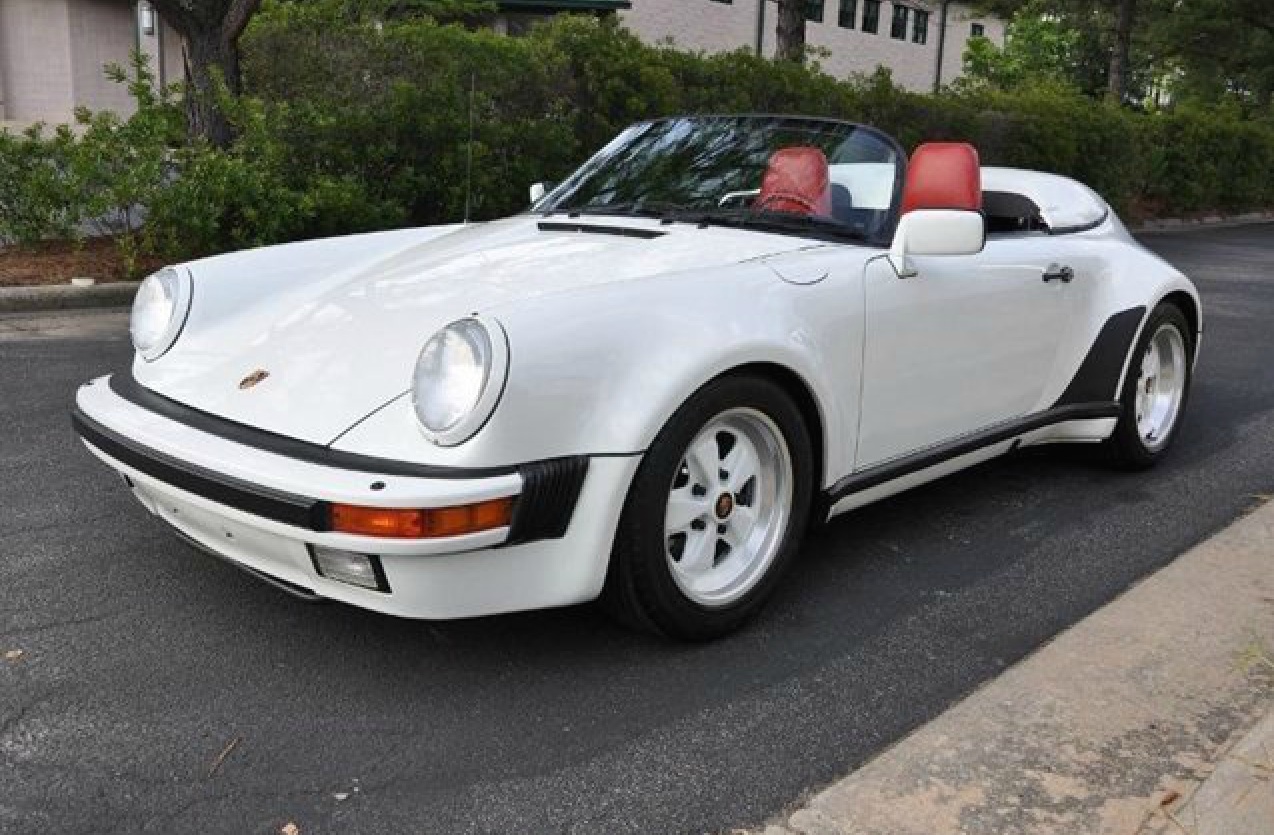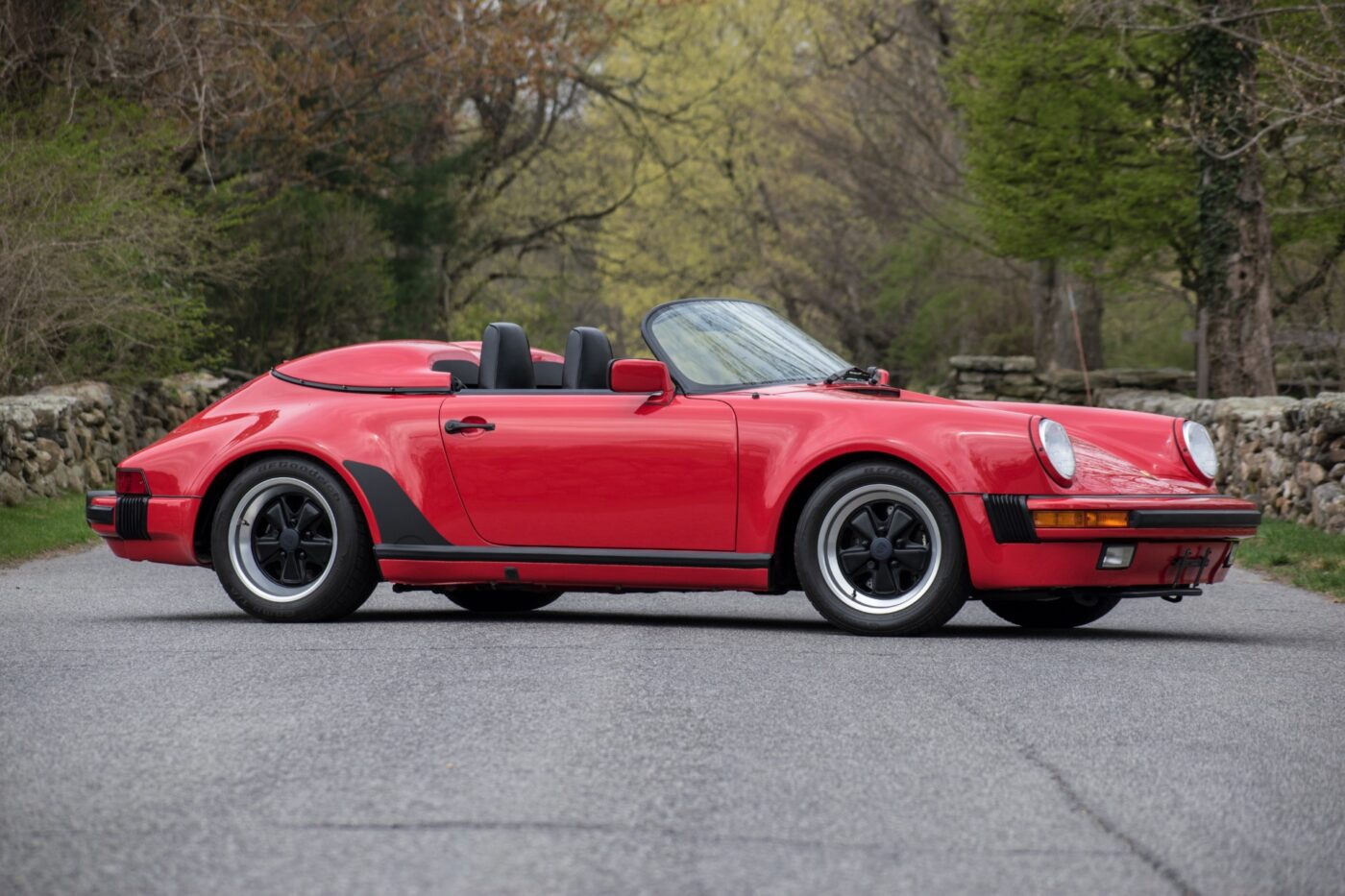1989 Porsche 911 Speedster – Ultimate Guide
The first Porsche 911 Speedster was built in 1989 and it was the last vehicle with the old 911 body. Inspired by the 911 Speedster concept from 1985, Porsche decided to build a production Speedster.
It was launched for the 1989 model year which was the 911s 25 year anniversary and had direct design attributes from the 356 speedster including a raked windshield, two-seat configuration, and roll-away roof for that stowed neatly under the double-bubble rear tonneau cover. The car was available in either narrow or Turbo-look widebody, with the latter outselling the former by a huge margin.
Important Note: If you search online you may see that the Porsche 964 Speedster came in two distinct incarnations. The 1989 model year Speedster (the one we are talking about on this page) was basically a 3.2 liter Carrera chassis with parts thrown in from the 930 Turbo. The “true” 964 Speedster was the 1994 Speedster which was based on the 964 Carrera 2 platform.
The Speedster Name
One of Porsche’s most iconic cars ever was the 356 Speedster. The uniquely designed Speedster first came to life in 1954, initiated because U.S. Porsche importer Max Hoffman wanted a stripped-out, less expensive and more driver focused car. Porsche delivered that in spades with the 356 Speedster. The ’54 to ’57 356 Speedster was priced below $3,000, featured minimal standard equipment, and boasted a raked, chopped, and removable windshield. Buyers loved them.
The last of the Porsche 356 Speedsters was the 1959 model year and it would take three decades before the name returned again on the 1989 Speedster.
The Background
The 1989 911 Speedster came at a rather troubled time for Porsche. Prior to 1989 the brand was growing quickly and doing really well, but a U.S recession meant Porsche was really starting to struggle. Porsche was hoping this limited model (and the new 964) would help drive faster sales growth.
The 911 Speedster was first conceived in 1983 and was meant to be much like the original 356 Speedster, a simpler, lighter, and less expensive open model that could be used as a daily driver in nice weather or be hustled on track car with ease. The new Speedster would have the aggressive look that included front fenders, quarter-panels, and wide alloy wheels borrowed from the 930 Turbo. With a sharply angled, cut down, removable windshield and the rear of the cockpit covered by a fiberglass tonneau cover, it was clearly a Speedster and it looked like nothing else on the road.
In 1983, Porsche engineer Helmuth Bott crafted a Speedster prototype from a 911 body. Three years later, Porsche President Peter Schutz green-lit development on another prototype. A second prototype was built in 1986 and was unveiled as a 911 SC-based concept at the 1987 Frankfurt Auto Show, where it drew a lot of press and excitement. Porsche decided to build the Speedster as a limited-production model on the next-generation Type 964 chassis then under development. However, when manufacturing delays slowed the 964’s introduction, the new Speedster was built on the 3.2 liter Carrera chassis, which was nearing the end of production.
The Speedster ended up being the last rear drive model produced on the 911 Carrera platform of the eighties. Production began in 1988.
1989 Speedster Details
The Porsche 911 Carrera Speedster launched in 1989 as a one-year special. It had a frameless, raked windshield that was also 3.1 inches shorter than a Carrera’s. At the rear, the dual hump tonneau cover replaced the back seats, and to the driver’s right and left were roll-up windows. The car did coming with “only use if it rains” cloth top.
The Speedsters were equipped with the H-program’s 3.2-liter air-cooled flat six engine. It gave the Speedster 231 horsepower and 195 lb/ft. of torque. Power was fed through a five-speed Getrag G50 transaxle, and there were power-assisted, ventilated, and cross-drilled disc brakes with alloy calipers at all four corners. Turbo-look Speedsters were fitted with 7J and 9J 16-inch-diameter Fuchs forged alloy wheels and larger tires. Beneath the fiberglass rear tonneau, the rear seats were replaced by a carpeted storage area.
The 911 Speedster saved some weight over the Cabriolet, coming in about 150 pounds lighter thanks to the removal of the roof frame and the non-inclusion of electric windows and other interior fittings.
Extremely Fun to Drive
The first thing you note about the 911 Speedster is that awesome 3.2 liter Carrera engine that sounds great in the open air with air rushing by your head. Air is something you better get used to with the Speedster too, because raking the screen back an extra five degrees causes a lot wind buffeting at speed. That is part of the experience though so it would not turn me off buying one.
It drives similar to the Carreras of the era in that you do need to watch it and drive within your comfort level because it can get you into all sorts of trouble. Get it wrong on a damp corner and lift off when you shouldn’t and …. well you know how the rest goes.
Like Carreras of the era, the steering is alive and you know you are in charge. Great brakes, fun gearbox and that epic engine are all accounted for in the Speedster. One of the best driving Porsches of the era for sure.
Limited Production
The Speedster was listed for roughly $65,000 when new. Porsche was surprised by the sales demand for the 1989 Speedster, it was an instant hit.
It did not look like a regular 911, it was rare and it had the historic name and details that drew buyers in. It also gave owners a more visceral driving experience when compared to the regular Carrera 3.2 on which it was based.
Despite the sales demand for the 1989 Speedsters, only 2,104 were ultimately sold. 171 of them had the narrow bodies while the rest were had the Turbo-look widebody configurations. About 800 left hand drive Speedsters ended up in the U.S with the rest scattered across Europe.
With only the 2,104 cars produced you now know why a good Speedster is now very expensive and only likely to continue to increase in value.
Buyers Guide
Finding (and affording) a 1989 Speedster are the only barrier to ownership. With so few on the market, coming across a proper car will take plenty of time. As always look for a car that has great Porsche dealer history with all the appropriate rubber stamps in the service book. Copies of old bills and past MoTs are essential too.
Condition-wise, look for a clean car with less than 50,000 miles. Galvanised bodies mean that rust is less of a problem than accident damage and general neglect. Definitely get any prospective cars inspected at a Porsche dealership, it is worth the money invested.
We cannot emphasize enough that with a car this age, condition is important. Do not assume you can just refurb things for a few thousand dollars and things will be rosy. Things like heat exchangers, exhausts, timing chains, clutches and brakes can run into thousands each so don’t take on a tired car hoping to make it good.
Overall, the 1989 Speedster is rare, fun and historic and makes a great car to drive and even better investment if you can get your hands on a mint condition example.
Pictures
Videos
The 1989 Porsche 911 Speedster is a pretty rare Porsche so the fact that we were able to track down a few high quality videos made us happy. The first two videos are both reviews while the third is a view on values (the video is a little older).



















